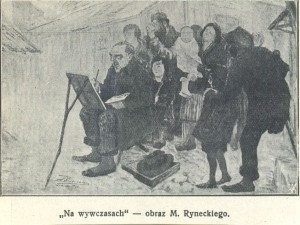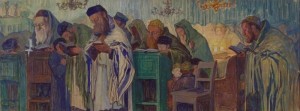For the last few months I have worked quite hard to track down several of my great grandfather’s paintings that I’d recently learned about. I am still working on obtaining images from several different sources, but in the meantime am happy to enjoy gazing at images of two paintings I received from the Muzeum Narodowe w Warszawie (The National Museum in Warsaw). As to how the Museum came to have the paintings in their possession, I was told that in 1963 an individual (a man) sold the paintings to the museum. When pressed for more information (e.g., who was this man? how did he have the paintings? did he have others? what was his name?) I was told that[Read more…]
Chasing Portraits – A Found Piece (sort of)!
My search for paintings (or reprints of paintings) by my great-grandfather is an endless and time-consuming task. I search the internet and I look for clues in various Polish language resources I can locate. Today I received a black and white newspaper clipping with an image of a painting of my great-grandfather’s. I do not know if the original still exists and, if it does, where it lives. The style seems somewhat different to me from the pieces I know so well, but I recognize the signature. The saga continues…
Fragments of Memory
Although there are many gaping holes in my knowledge of my family’s war time story, the one story that I do know is one my grandfather told me when I was about eight years old. The way I remember it, my parents and I were visiting my grandparents’ home when, during a pause in the conversation, my grandfather announced he wanted to tell me “A true family story.” The story begins in June of 1943. My father and grandmother have been arrested by the Polish police on the streets of Warsaw. But just as Grandpa is getting going in the story, Grandma stands up and interrupts him. “Don’t tell this story. Please,” she begs, “no war stories.” Grandpa tells her I’m old enough to hear the story, that it’s his home, and he can tell his granddaughter whatever he pleases. Grandma shakes her head; the rush of wartime memories seem to fill her mind and send her reeling. She yells at Grandpa in Polish. I don’t speak Polish, so I have no idea what she’s saying, but her voice shakes and trembles, and she’s on the verge of tears. It’s clear to me that she does not want grandpa to tell this story. Grandpa responds to her pleas with a raised and unsympathetic voice. Grandma starts crying and leaves the[Read more…]
Living in the Shadow of the Holocaust
Moshe Rynecki (1881-1943), my great-grandfather, was an artist. He wasn’t supposed to be an artist. His father, Abraham, a religious man, and a fairly successful business man (he operated a clothing factory specializing in hand sewn uniforms) did not approve of Moshe’s ambition to paint. Abraham, an Orthodox Jew, believed painting violated the Second Commandment, “You shall not make for yourself an idol, whether in the form of anything that is in heaven above, or that is on the earth beneath, or that is in the water under the earth.” [Read more…]
Jewish Artist or Artist Who Is Jewish?
[Note: I originally posted this on my blog in March 2012. In June 2014 I posted it in a Huffington Post blog with the title, “The Art of Moshe Rynecki,” along with a slideshow of several Moshe Rynecki paintings.]
The category of Jewish Art History cannot be simply subsumed into a generalized European art history. The modern artist as the author-agent of the work of art is a relatively new persona and figure for Jews, emerging only in the nineteenth century along with greater historical movements of emancipation for Jews in Europe. My great-grandfather was split between affinities: on the one hand, he was a painter of traditional Jewish life in Poland, settling his gaze upon scenes of synagogue, teaching, labor, and leisure. In this, his paintings are an invaluable source of visual information about a world that has vanished. [Read more…]

